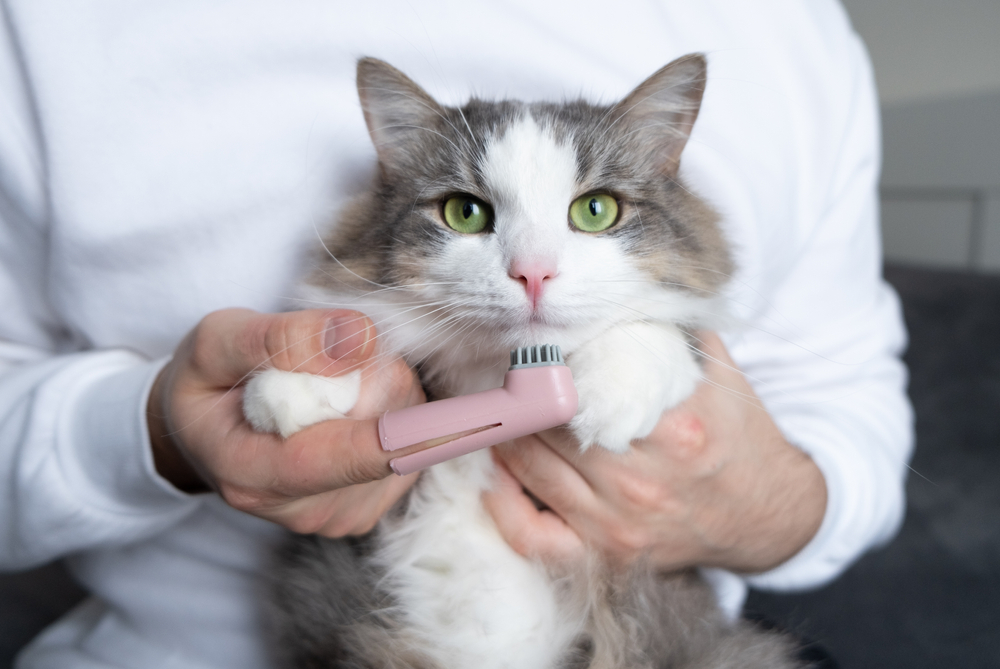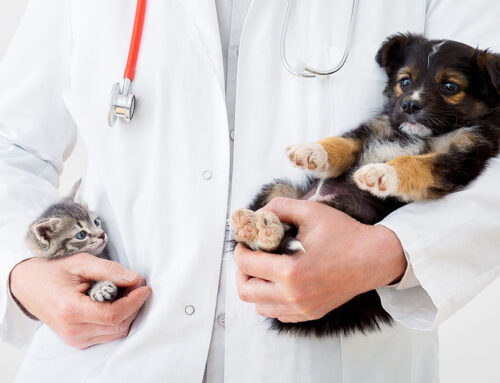You need to establish routines for your pet’s essentials—potty training puppies, teaching obedience commands, and thwarting disease through preventive care. One of the most important routines you can establish for your pet—which has some of the farthest-reaching consequences—is to practice daily dental care. Without regular dental care, oral bacteria can take over your pet’s mouth, infiltrate their bloodstream, and invade their organs. Your furry pal can suffer loose teeth, tooth-root abscesses, and jawbone loss. If your pet’s dental disease is allowed to progress, your furry pal can develop systemic infection, or heart, liver, or kidney disease.
By implementing your pet’s daily oral care routine, you can prevent dental disease from taking root. Follow our Veterinary Medical Center of Indian River County team’s five steps to tackling your pet’s stinky breath and dental problems.
Step #1: Evaluate your pet’s oral health regularly
Knowing your pet’s dental health status is important for identifying early disease and procuring treatment before serious problems develop. Get in the routine of flipping up your pet’s lip to check for periodontal problem signs such as:
- Bad breath
- Red, inflamed, swollen, or bleeding gums
- Grey, yellow, or brown plaque and tartar accumulation
- Excessive drooling
- Ropey saliva
- Loose, worn, cracked, or missing teeth
- Oral masses or ulcers
In addition to looking inside your pet’s mouth, watch their behavior. Dental disease can cause behavioral signs such as:
- Refusing to eat dry food or hard chews
- Licking the juice off but leaving canned food uneaten
- Dropping food while eating
- Chewing on one mouth side
- Appearing eager to eat, but refusing
- Avoiding playing with or chewing toys
Many pets hide obvious dental disease signs until their condition has progressed to a painful state or serious infection. Regularly check your furry pal’s mouth for early dental disease signs to ensure they receive prompt treatment.

Step #2: Provide daily at-home dental care for your pet
Stay on top of your pet’s oral health by providing daily care at home. Without regular, frequent dental care, plaque forms on your pet’s teeth within 24 hours of eating, which then mineralizes into tartar after 72 hours. If you can’t brush your pet’s teeth daily, perform at least some form of dental care every day—tossing your furry pal a dental chew or a handful of dental treats, adding enzymatic cleaning agents to their food or water, or swiping a dental wipe across their teeth. Every little bit helps prevent your pet’s plaque formation.
Step #3: Avoid giving your pet tooth-damaging toys
Many chew toys marketed for pets can do more harm than good to your four-legged friend’s dental health. Flavored bones, antlers, and hooves pose threats to your pet’s teeth, and if swallowed, to their gastrointestinal (GI) tract. If your pet chews a toy that is too hard, such as a bone, the product can fracture your pet’s teeth. Although your furry pal may be a power chewer, rather than giving them chew toys that are stronger than their teeth, offer your pet treat-dispensing toys or ones made of durable rubber, such as Kongs, Goughnuts, or West Paw toys. Always monitor your pet closely when they’re chewing a toy, and check the item regularly for damage.
Step #4: Choose approved dental health products for your pet
An overwhelming number of pet dental health products are available. Discerning whether a pet dental product holds up to claims that the item prevents dental disease can be a challenge. Fortunately, the Veterinary Oral Health Council (VOHC) has approved many effective dental health products, which have proven their efficacy in slowing plaque and tartar accumulation, and helping keep your pet’s mouth healthy. To determine if a pet dental chew, treat, food or water additive, or oral spray, rinse, or wipes will be worth a try, look for the VOHC Registered Seal on packaging.
Step #5: Schedule professional dental cleanings with your veterinarian
Another key step to ensure your pet receives essential dental care is to schedule their routine professional dental cleanings. Rather than waiting until your pet shows obvious, painful dental disease signs, stay on top of their oral health by scheduling annual dental cleanings. Most pets require annual cleanings by age 2 or 3, while some pets require more frequent cleanings to keep stomatitis, and resorptive and periodontal diseases at bay.
During a professional dental cleaning, your pet will be given anesthesia, which allows our Veterinary Medical Center of Indian River County team to perform a comprehensive oral exam, take dental X-rays to search for hidden disease, and effectively scale away plaque and tartar from above and below the gumline. Anesthesia also enables us to perform oral surgery, such as tooth extractions, to remove damaged or diseased teeth without causing your pet undue pain. We finish the cleaning by polishing the enamel smooth to help prevent future plaque from adhering to your pet’s teeth.
Regular professional dental cleanings—paired with at-home oral care—are essential to keeping your pet’s breath fresh and their teeth healthy. Schedule your pet’s annual wellness exam and professional dental cleaning with our Veterinary Medical Center of Indian River County team.







Leave A Comment